|
|||
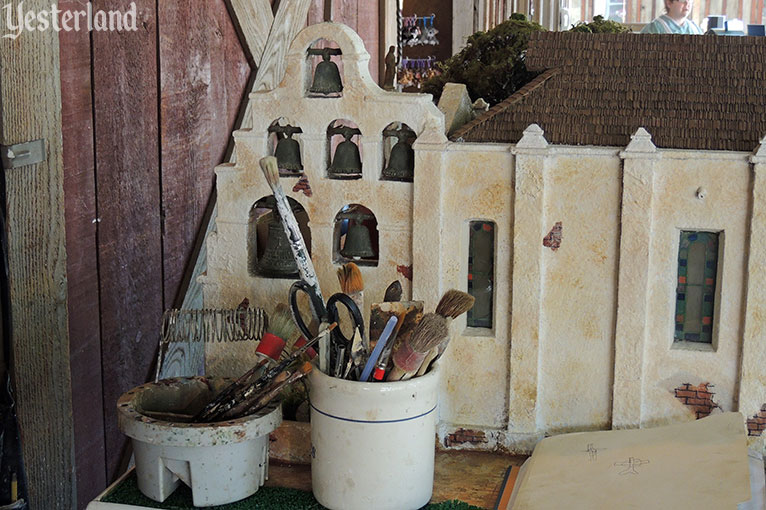
Photo by Werner Weiss, 2013 |
|||
|
It may seem like an odd theme park attraction. Back when admission to Knott’s Berry Farm was free, Walter Knott commissioned dioramas of the California missions. Displayed in 21 glass-fronted cases—usually with a wooden wall a few feet in front of the glass (and a roof above the space) to limit reflections and to control lighting inside—the detailed models allowed Knott’s guests to journey up the length of California without leaving the park. It was a free attraction and had no sponsor. Of course, Walter Knott hoped guests would spend money elsewhere on the “Farm.” The dioramas were about history. But as Knott’s morphed into a thrill ride mecca, the dioramas became history. Around 60 years after the mission models were built, they are being rebuilt. Guest contributor M.H. Habata has been watching the progress and wrote this article for Yesterland.
|
|||
|
|
|||
|
If you visited Knott’s Berry Farm between the 1950s and mid-1990s, you might remember that the park once had a collection of large models of the 21 California missions on display between Calico Square and what became Fiesta Village, celebrating California’s Spanish heritage and early history. Those mission dioramas have been missing from the park for over fifteen years, but since March 2013, the entire set of 21 missions is being restored by craftsman Bob Weir, a wood carver who has worked at Knott’s for over 25 years. Along with recent refurbishments of the Timber Mountain Log Ride and the Calico Mine Train and revitalization of Ghost Town buildings, Knott’s management is increasingly recognizing the park’s celebrated history, which began in the 1920s. |
|||
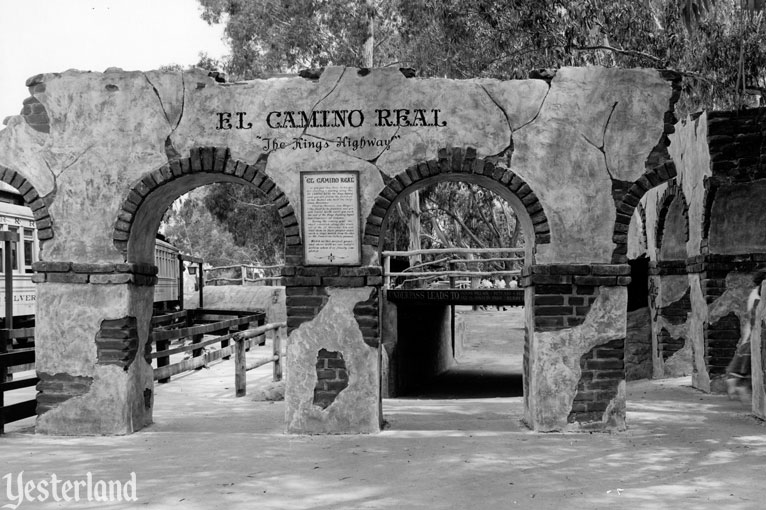
1956 photo from the Knott’s Berry Farm Collection, Orange County Archives; used with permission Knott’s Berry Farm’s El Camino Real south arches, near the train depot |
|||
|
For those who did not attend elementary school in California or who are rusty on their California history, the missions were founded by Spanish Franciscan monks starting in 1769 (seven years before the signing of the Declaration of Independence) to extend Spanish influence into Alta California and to convert Native Americans living near the missions to Christianity and thus “civilize” them. Starting with the first mission in San Diego, Father Junipero Serra and his successors eventually founded 21 missions along the coastal areas of California. Over time, control of California passed from Spain to Mexico and ultimately to the United States, but by the mid-nineteenth century, the missions had been largely dismantled and fell into disrepair. In the early and middle twentieth century, however, interest in the missions was revived as the state’s Spanish period was romanticized in popular culture and the 21 missions along El Camino Real (“the King’s Highway”) became a tourist draw, promoted by the state’s Auto Club and local boosters. |
|||
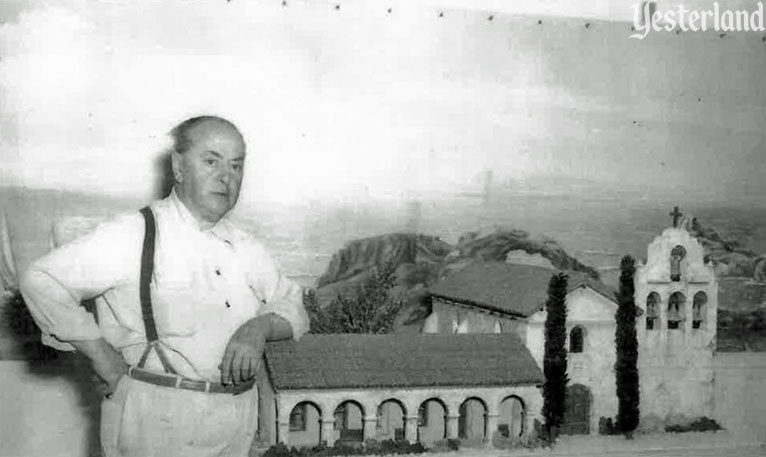
Photo from the collection of Chris Jepsen, O.C. History Roundup, used with permission Leon Bayard de Volo standing next to his model of Mission Santa Inez, probably in the late 1950s |
|||
|
It was in this context that Walter Knott, founder of Knott’s Berry Farm, commissioned Italian-born artist Leon Bayard de Volo in the 1950s. De Volo had worked in set design in New York and in Hollywood. He would build models of the 21 California missions to line the path between the stagecoach route (still in use) and Reflection Lake (a smaller version of the lake exists today under the Silver Bullet roller coaster). In addition to the mission models, Knott had his own version of El Camino Real constructed with elaborate Spanish style archways at both ends of the path. The new attraction opened in 1956, starting just beyond the railroad station near Calico Square, and predating the 1969 opening of Knott’s second themed area, Fiesta Village, which features a Mexican theme. |
|||
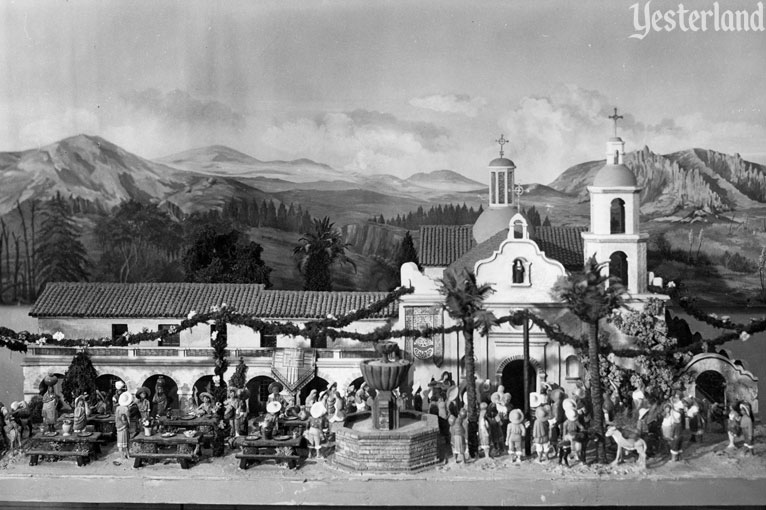
Photo from the Knott’s Berry Farm Collection, Orange County Archives; used with permission Diorama of Mission San Luis Rey (Oceanside, California) at Knott’s Berry Farm |
|||
|
Beginning in the mid-to-late 1980s, the mission dioramas began to disappear gradually from Knott’s. A few dioramas survived into the new Millennium, but they disappeared too. Orange County Assistant Archivist Chris Jepsen was surprised to discover the models mostly intact on the second floor of the Gold Trails Hotel in 2009, but it wasn’t until 2013 that the park announced that their wood craftsman (Bob Weir) would begin restoring de Volo’s missions in public view in Ghost Town. Weir, who has worked for Knott’s for twenty-seven years and once taught at a local Orange County high school, has worked on similar projects at Knott’s, like the massive totem pole at the entrance to the Indian Trails area and directly behind the Wagon Camp amphitheater. |
|||
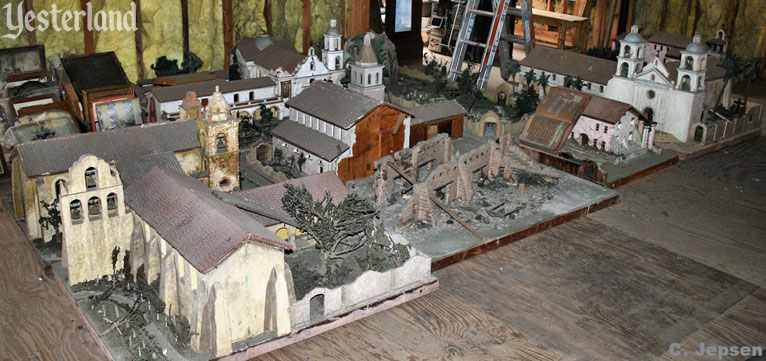
Photo by Chris Jepsen, 2009, courtesy Chris Jepsen De Volo mission models in storage on the second floor of the Gold Trails Hotel |
|||
|
I first visited Mr. Weir in June 2013, when he was working on his second Knott’s model restoration, Mission Santa Inés. He described for me the work that de Volo had done in originally building the models, as well as the scope of his own project (restoring 16 of de Volo’s 21 models, and building five new models from scratch to replace those that could not be salvaged). Mr. Weir told me that the interior structure of the missions had been created entirely of pine wood, and that in building the models de Volo had used animal glue, which was commonly used in the 1950s, when Mr. Weir was first starting out in the business. |
|||
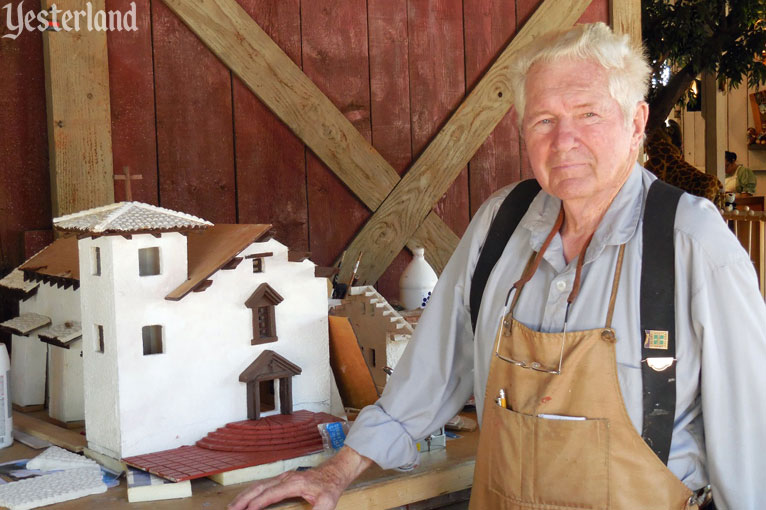
Photo by M.H. Habata, 2015 Wood craftsman Bob Weir with his restored model of Mission San Jose |
|||
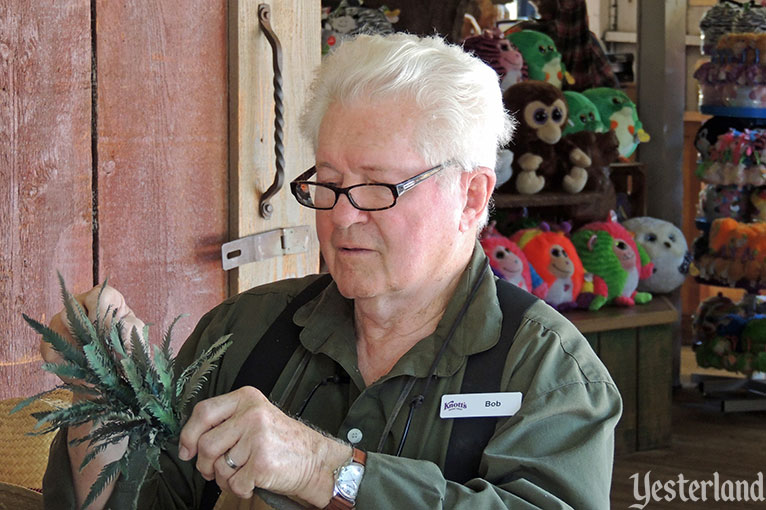
Photo by Werner Weiss, 2013 Weir working on a miniature palm tree… |
|||
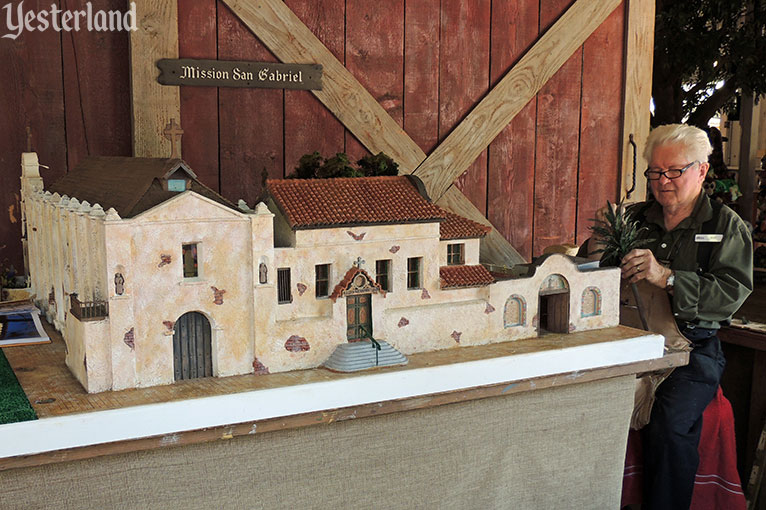
Photo by Werner Weiss, 2013 …for Mission San Gabriel |
|||
|
I also noticed that Mr. Weir actually had two different jobs: renovating the mission models using a variety of equipment, but also engaging visitors to his work area near the Toy Barn (formerly the Livery Stable) in Ghost Town. This involves interesting visitors in his work and giving mini-lessons on Father Serra and the California Missions, Leon de Volo’s original work, and the craft of woodworking and the restoration process. |
|||
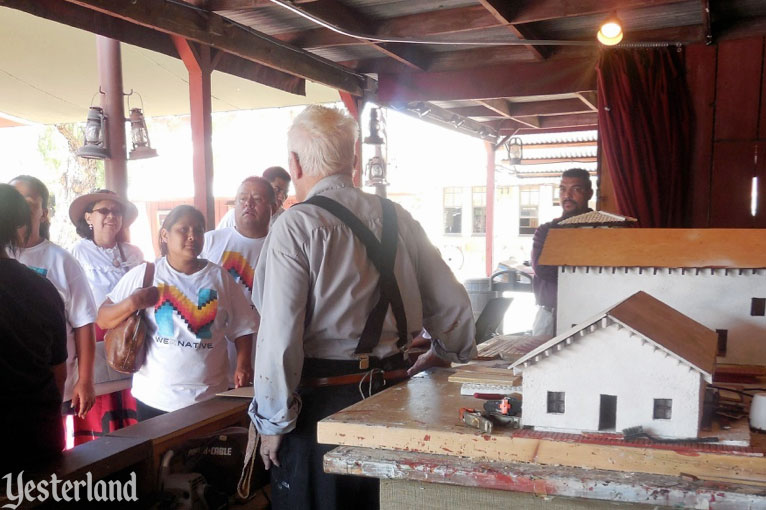
Photo by M.H. Habata, 2015 Bob Weir speaking with a Native American school group, July 2015 |
|||
|
Unlike entertainment-focused parks like Disneyland or Universal Studios, Knott’s Berry Farm hosts a large number of school groups throughout the year, and giving a presentation and answering questions can take a lot of his time. As much as Mr. Weir seems to enjoy talking to park visitors and school groups, I imagine that there must be a certain amount of progress in his restoration work required each week. Visiting Knott’s and watching Bob Weir work throughout the remainder of 2013 and during 2015, it struck me that working outdoors in the public view (even under a roofed area) is not like working in a climate-controlled office, especially when it’s 100 degrees in the dog days of summer, or when it’s 45 degrees on a bitterly cold morning. |
|||
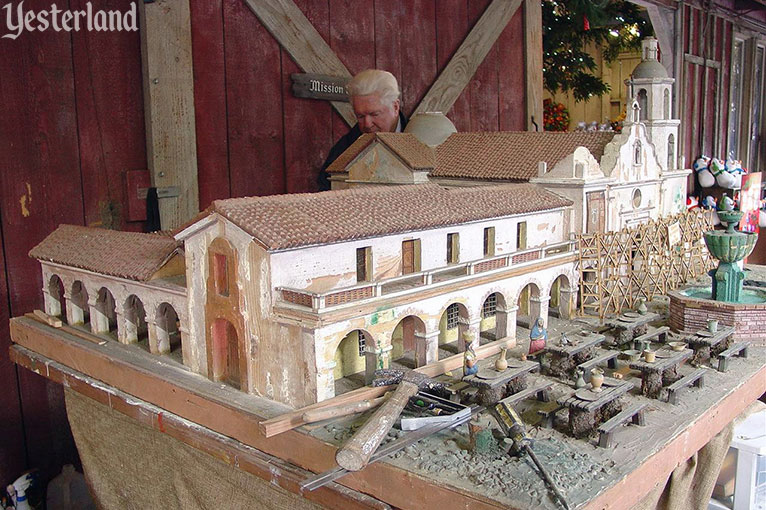
Photo by M.H. Habata, 2013 Bob Weir beginning work on Mission San Luis Rey, December 8, 2013 |
|||
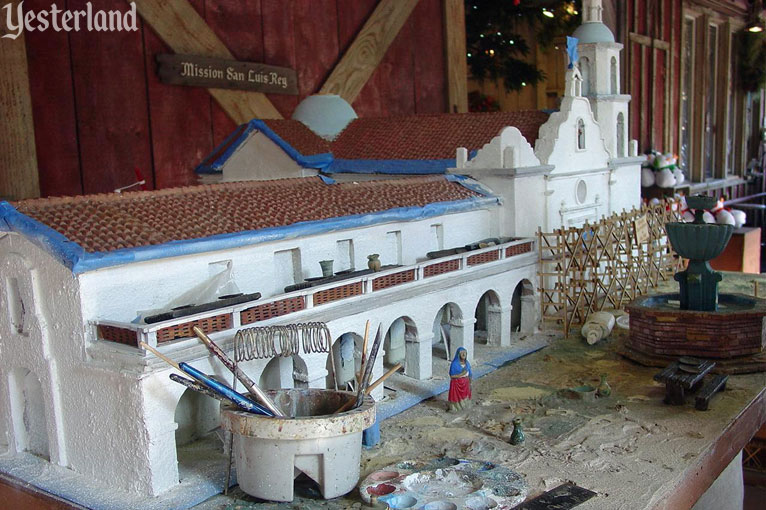
Photo by M.H. Habata, 2013 Restoration well underway on Mission San Luis Rey, December 22, 2013 |
|||
|
Those learning California history today in school have a different perspective on the accomplishments of Father Serra and his contemporaries than those who went to school a generation or two ago. Junipero Serra is a controversial figure today because Native California peoples were relocated by force to the missions, and their ways of life and populations were decimated by the mission system Serra established. Mr. Weir told me that Native American groups, in particular, visiting Knott’s sometimes have a negative reaction to seeing the missions. At the same time, in my conversations with Mr. Weir, he doesn’t sugarcoat the negative aspects of what happened at the missions, and is willing to talk about both positive and negative sides of the missions’ history. I’ve more frequently overheard visitors commenting that the restoration work is not so different than their fourth-grader’s project to build a mission model. A couple of things make his work different: Mr. Weir visits the actual mission as much as possible to take notes, make photographs, and plan out his work. This year, he made a trip to northern California to plan out the remaining models he is building based on the missions in Sonoma, Fremont, Soledad, and San Francisco. He told me that he is saving Mission San Francisco de Asis (Mission Dolores) for his last project because it is relatively complex, with a slanted roof along the length of the building that is also higher at the front of the building and gradually descends towards the back. |
|||
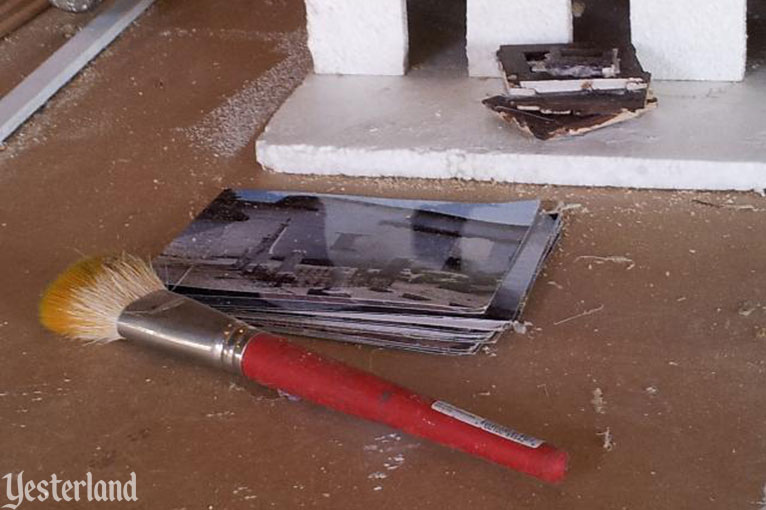
Photo by M.H. Habata, 2015 Stack of photos of Mission San Jose being used as a guide for the construction of the model |
|||
|
Also, Mr. Weir told me that he uses something called G Scale for the mission models, which means one half inch on the model = one foot on the actual building. Part of the renovations for the first seventeen models involved adding miniature plants and other decorations, which Mr. Weir said were close to the relative size they would be in real life. Several of the mission models also have human figures which were from Leon de Volo’s original models, not added by Mr. Weir. |
|||
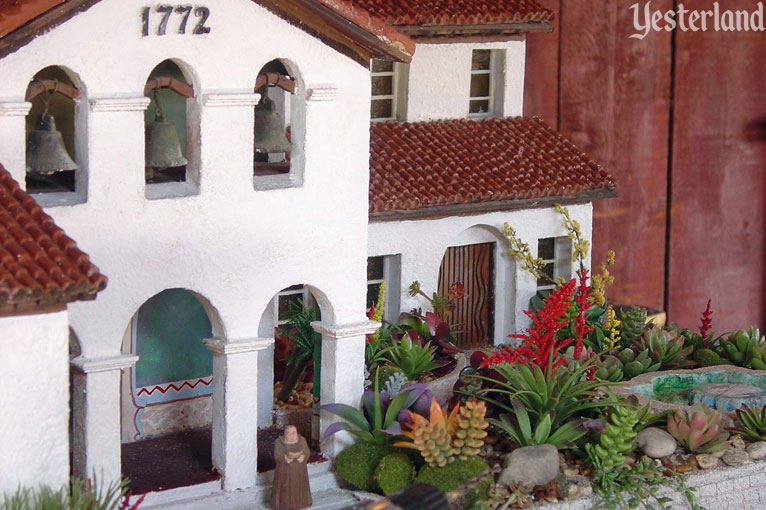
Photo by M.H. Habata, 2013 Some of the plants and a monk figure decorating Mission San Luis Obispo, October 2013 |
|||
|
The original models on display along Knott’s El Camino Real were in glass-front cases with painted backgrounds. Mr. Weir told me that the park management had asked him to restore the models so they would be visible from all four sides, which meant doing original work on the back sides of some of the models which were left unfinished since they were designed to be visible only from the front and sides. |
|||
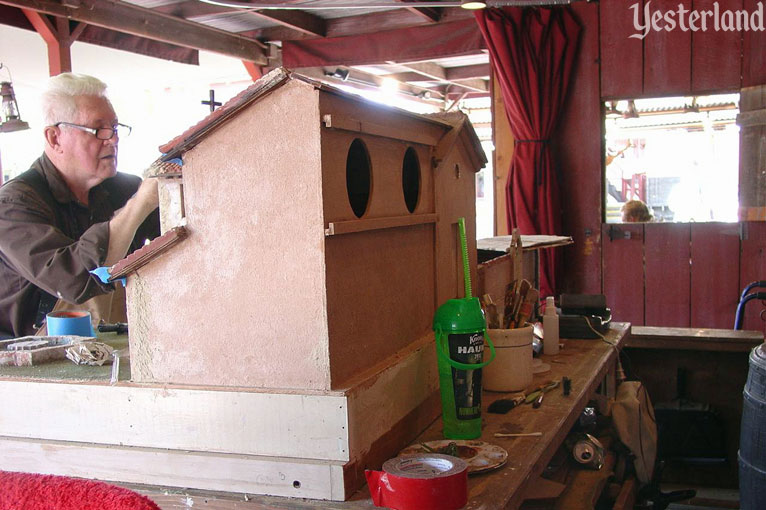
Photo by M.H. Habata, 2013 The backside of Mission San Luis Obispo, as created by Leon de Volo, shows no decoration or paint |
|||
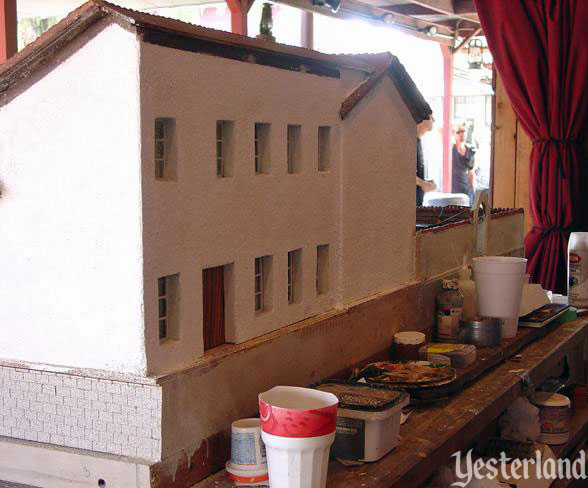
Photo by M.H. Habata, 2013 One month later, the backside of Mission San Luis Obispo is ready for display |
|||
|
By the end of 2014, Bob Weir had finished restoring the sixteen existing de Volo models, and in January 2015, he started building Mission San Diego from scratch. The process was a lot more involved than restoring an existing model. From observing the progress on this model, it appears that first a cardboard cutout of the approximate walls is made, then the walls of the buildings are made from wood. Next the decorative elements like parapets and balustrades are added to the wooden structure, and then the coating and paint are applied to the walls. The tile roofs and exterior walkways are built separately from the building structures. Mr. Weir told me that one of the additional challenges of the final mission dioramas is matching the scale of the new models to the existing de Volo models that he has already restored. |
|||
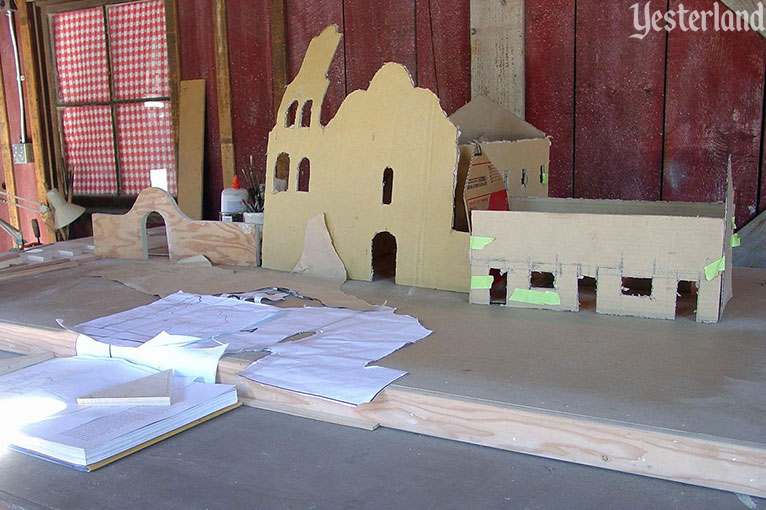
Photo by M.H. Habata, 2015 Mission San Diego, the first model Bob Weir built from scratch, under construction on January 6, 2015 |
|||
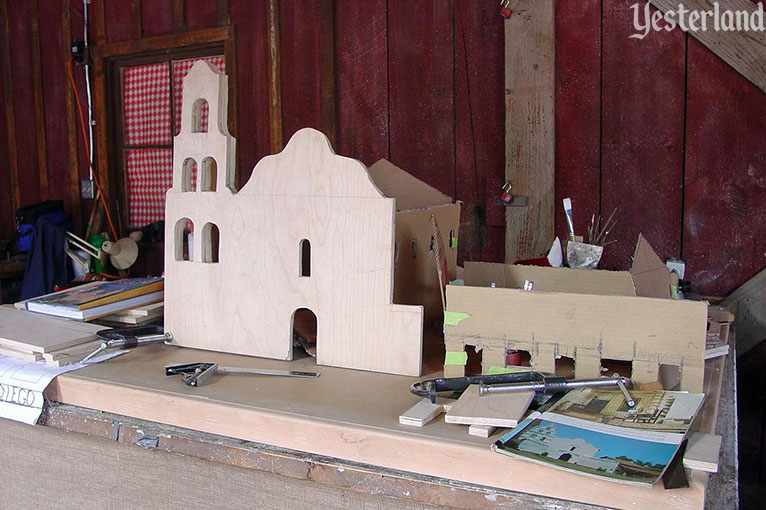
Photo by M.H. Habata, 2015 January 16, 2015 |
|||
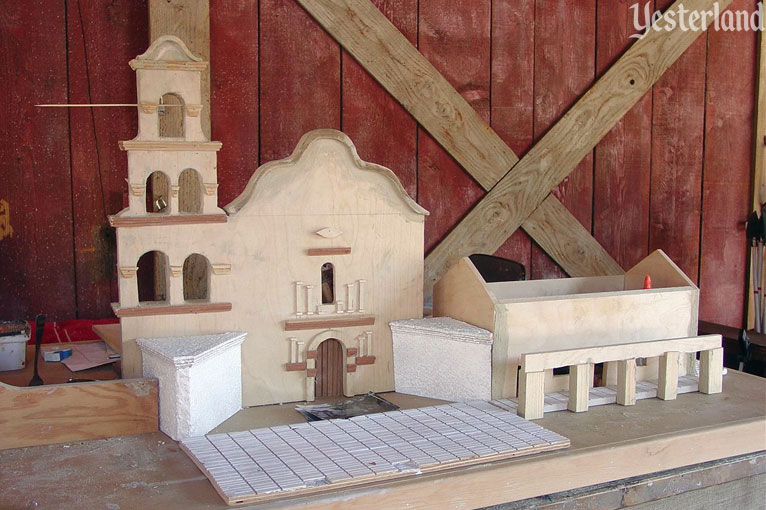
Photo by M.H. Habata, 2015 January 27, 2015 |
|||
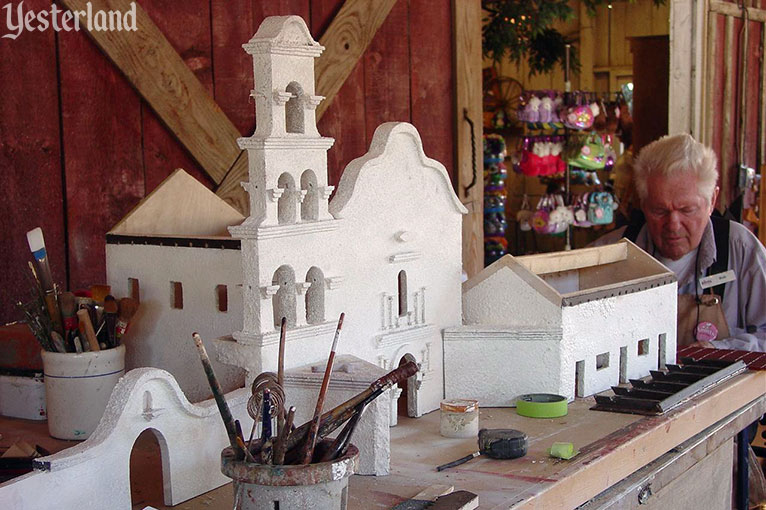
Photo by M.H. Habata, 2015 February 15, 2015 |
|||
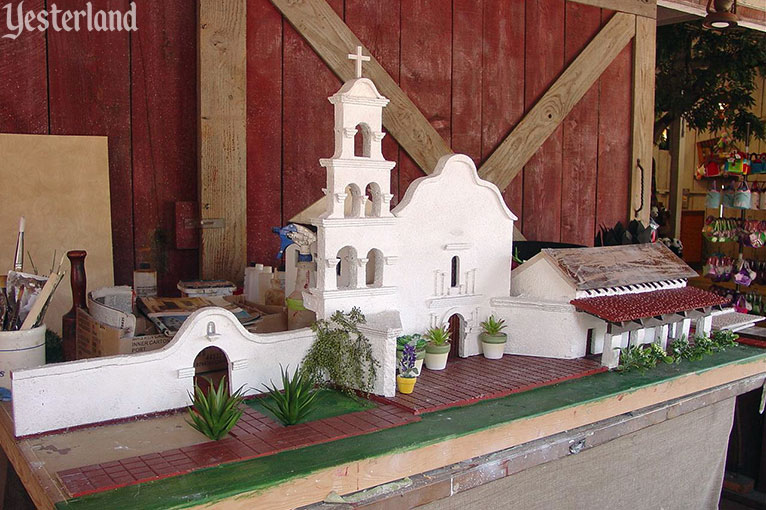
Photo by M.H. Habata, 2015 March 7, 2015—almost completed |
|||
|
From the beginning of the project, there was hope that they would be displayed near the area where they had been originally been located, along the walkway alongside the stagecoach route. Bob Weir reported that Knott’s management is looking at a number of possible locations, and that they are trying to ensure that the dioramas would be secure in the event that they were displayed outside the park gates. |
|||
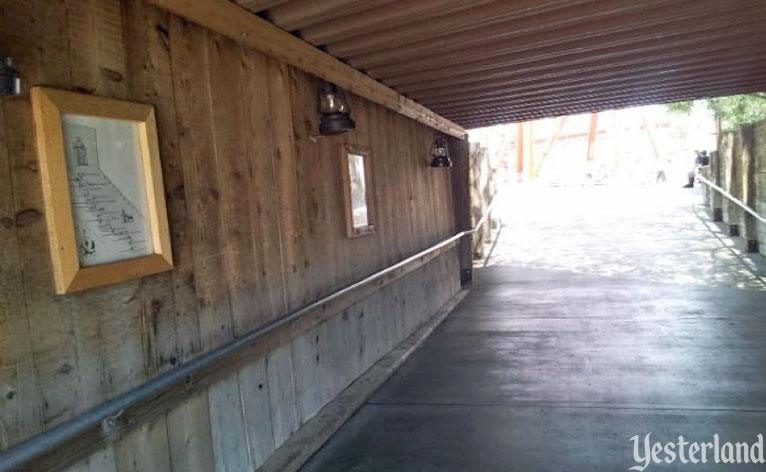
Photo by M.H. Habata, 2015
The tunnel under the stagecoach path where the first mission models were |
|||
|
Mr. Weir expects to be able to finish the remaining mission models within the next two or three months, and then spend several more weeks doing touch-up of the 21 missions he has finished before they are put on display. If you would like to see him at work, he tends to work during the weekends and take Tuesdays and Wednesdays off (the park is open every day except Christmas), though his schedule is not completely fixed. Congratulations to him for what will be almost three years of work, restoring the Leon de Volo models, building five replacement models, and giving park visitors and school groups a chance to view his craftsmanship and ask questions. And congratulations to Knott’s for recognizing the value of the original missions, and committing the resources to restoring them and returning them to public view. — M.H. Habata |
|||
|
A Note from Werner about Knott’s Preserved Knott’s Preserved is a wonderful book about the history of Knott’s Berry Farm—with a perfect balance of color illustrations and well-researched text. The original edition, published in 2010 (and reviewed at Yesterland here), is out of print and sold out. It is available through Amazon and other sellers of used books and collector books—but often at sky-high collector prices. Now there’s good news! Please read on… |
|||
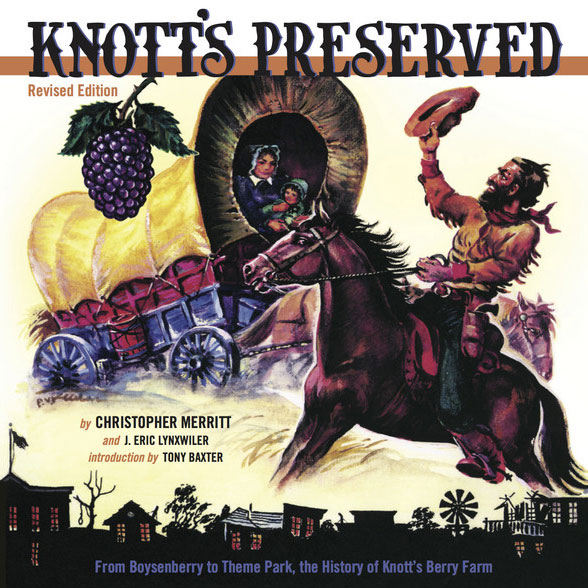
Angel City Press Knott’s Preserved [Revised Edition] |
|||
|
Authors Christopher Merritt and J. Eric Lynxwiler and publisher Angel City Press have released a 176-page revised and expanded second edition. Knott’s Preserved [Revised Edition] (2015) is available:
hardcover |
|||
|
Click here to post comments at MiceChat about this article.
© 2015-2020 Werner Weiss — Disclaimers, Copyright, and Trademarks Updated February 7, 2020. |
|||